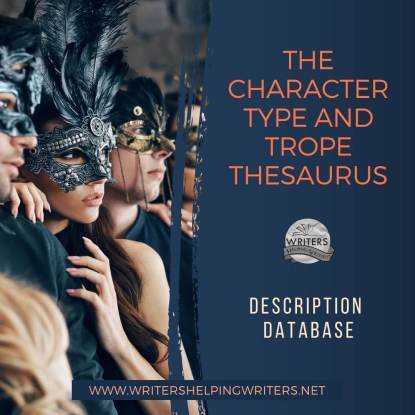Introducing…The Character Type & Trope Thesaurus!
Character building is hard work, and when we see certain types of characters appear again, and again in fiction and film, we wonder if there’s a way to start with a familiar character building block yet still create someone fresh. And with a little out-of-the-box thinking, we can.
I’m talking about using archetypes and tropes — characters who play a specific role in a story or who have a blend of characteristics that make them instantly recognizable: the Rebel, the Bully, the Hot Billionaire, the Chosen One…you get the idea. Readers recognize these types of characters and may even expect to find them in certain stories.

So, our job is done, right? Pick an archetype or trope, put some clothes on them and shove them into the story. No, ‘fraid not. Character types and tropes can provide a skeleton, but to avoid a stock character or overdone clich��, they must stand on their own and mesmerize by being unique.
And that’s where this thesaurus comes in.
Characters need layers, full stop, so trope or not, we want to dig for what makes them an individual, give them a soul, and make adaptations that will challenge a reader’s expectations.
What this thesaurus will cover:A Trope or Type Description and Fictional Examples. Before we can think about how to adapt a trope, we need to know more about who they are. This overview and examples will help you know if this baseline character is right for your story.
Common Strengths and Weaknesses. A character who aligns with a trope or type tends to have certain positive and negative traits, so we list those as a starting point. But don’t be afraid to branch out – personality is a great place to break the mold.
Associated Actions, Behaviors, and Tendencies. Because tropes have a mix of traits, qualities, and a worldview baked in, you’ll need to know how to write their actions, choices, priorities, and certain tendencies…so you can then decide how to break with tradition.
Situations that Will Challenge Them. Every character faces challenges in a story that are extra difficult because of who they are, what they believe, fear, and need. A trope or type character is no different. We’ll cue up ideas to get your brains whizzing on what this can look like in your story.
Inner Struggles to Give Them Depth. Oh, we’re getting to the good stuff now, people! Whether you start with a type or trope or craft someone from scratch, what makes a character a true individual is everything going on inside of them. Showcasing your character’s inner struggles, emotional tug-o-wars, clashing beliefs and needs…this is how you unearth someone with depth for readers to fall in love with!
Twist This Type With a Character Who… is where we give you ideas on how to break expectations, so you deliver someone who has fresh angles, and isn’t a typical stand-in.
Clich��s to Avoid is where we alert you to some of the overdone versions of a type or trope so you’re aware of them as you develop your characters and plot your story.
Readers are hardwired to look for patterns and familiarityWhich is why we see tropes used so often, but good storytellers know that in 99% of cases, using one is the starting point only. We want rounded and dynamic characters, not flat ones. So, unless you require a stock character to fill a background role, any character who starts as a trope should be as carefully developed as those who did not. Readers want–and deserve!–fresh characters, so dig into those inner layers and bring forth someone unique.
Join us next Saturday for the first entry, and if there’s a character type or trope you’d like us to cover, add it in the comments, and we’ll add it to the list of potentials!
The post Introducing…The Character Type & Trope Thesaurus! appeared first on WRITERS HELPING WRITERS��.
Writers Helping Writers
- Angela Ackerman's profile
- 1022 followers



